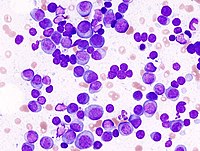
Photo from wikipedia
Cardiac involvement in systemic amyloidosis, due either to immunoglobulin light-chain or transthyretin amyloidosis, influences clinical presentation and is a strong predictor of unfavourable outcome. Until recently considered as a rare,… Click to show full abstract
Cardiac involvement in systemic amyloidosis, due either to immunoglobulin light-chain or transthyretin amyloidosis, influences clinical presentation and is a strong predictor of unfavourable outcome. Until recently considered as a rare, incurable disease, cardiac amyloidosis, is still mis/underdiagnosed, although treatments effective in improving patient survival are now available for both subtypes, including chemotherapy regimens for immunoglobulin light-chain amyloidosis and tetramer stabiliser for transthyretin amyloidosis. Achieving a timely diagnosis allows initiating life-saving therapies and requires the early recognition of clinical, laboratory and imaging signs of cardiac involvement, some of them may be apparent well before the disease becomes clinically manifest. Given the systemic nature of amyloidosis, a close interaction among experts in multiple specialties is also required, including cardiologists, nephrologists, haematologists, neurologists, radiologists, nuclear medicine specialists and internists. As an increased awareness about disease presentation is required to ameliorate diagnostic performance, we aim to provide the clinician with a guide to the screening and early diagnosis of cardiac amyloidosis, and to review the clinical, biohumoral and instrumental ‘red flags’ that should raise the suspicion of cardiac amyloidosis.
Journal Title: European Journal of Preventive Cardiology
Year Published: 2019
Link to full text (if available)
Share on Social Media: Sign Up to like & get
recommendations!